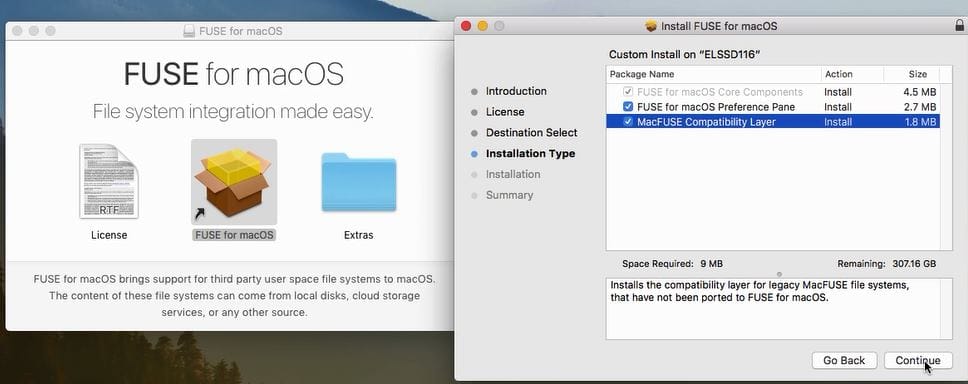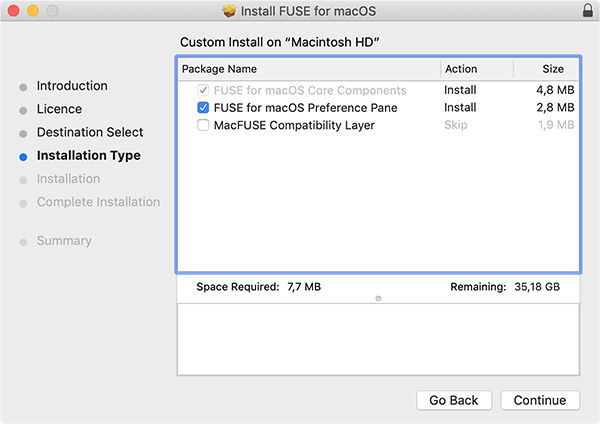
- #Fuse for macos for mac#
- #Fuse for macos mac os x#
- #Fuse for macos install#
- #Fuse for macos software#
#Fuse for macos install#
If you have a secondary drive in your system or have partitioned your primary drive, you can install Linux to this drive and dual boot your computer. Since the Linux OS will be the most compatible option for reading such a drive format, the first methods include simply installing Linux and using it as the filesystem management interface:
There are several approaches that can be taken to manage Ext2 and Ext3 filesystems in OS X. In addition to those who might wish to dual boot OS X with Linux and manage files in both environments, there are those who might simply have an Ext2- or Ext3-formatted external drive that they need to read on their OS X systems. Apple discussion poster " rcb4" asks: "I was wondering since I want to dual boot Linux and OS X, putting each respective OS on their own smaller partition and creating a large /home partition for all my data"

While Apple's cross-platform support is provided primarily for compatibility with Windows systems, there are instances when people may wish to use Linux disks with their Mac systems. While this support does allow a decent amount of flexibility in what disks can be handled by OS X, it does leave out support for some popular alternatives such as the ext2 and ext3 formats used in Linux. However, to increase cross-platform support Apple has included support for several other filesystem types, including FAT32, UDF, UFS, and NTFS (in read only mode), in addition to several networking filesystem protocols such as AFP, NFS, and SMB.
#Fuse for macos mac os x#
If you prefer another language (say, Python or Java), you should be able to create file systems in those languages after you install the relevant language bindings yourself.The primary filesystem format in OS X is Apple's HFS Plus (or Mac OS X Extended), which is the default used for any newly formatted disk. It comes with C-based and Objective-C-based SDKs.
#Fuse for macos software#
The FUSE for macOS software consists of a kernel extension and various user space libraries and tools. Therefore, many existing FUSE file systems become readily usable on macOS. It provides multiple APIs, one of which is a superset of the FUSE API (file system in user space) that originated on Linux. In more technical terms, FUSE implements a mechanism that makes it possible to implement a fully functional file system in a user-space program on macOS.

Since FUSE file systems are regular applications (as opposed to kernel extensions), you have just as much flexibility and choice in programming tools, debuggers, and libraries as you have if you were developing standard macOS applications. Writing a file system using FUSE is orders of magnitude easier and quicker than the traditional approach of writing in-kernel file systems. The content of these file systems can come from anywhere: from the local disk, from across the network, from memory, or any other combination of sources. Legacy MacFUSE file systems are supported through the optional MacFUSE compatibility layer.Īs a developer, you can use the FUSE SDK to write numerous types of new file systems as regular user space programs. It is a successor to MacFUSE, which has been used as a software building block by dozens of products, but is no longer being maintained.Īs a user, installing the FUSE for macOS software package will let you use any third-party FUSE file system.
#Fuse for macos for mac#
Mac os x 10.11 download free.įuse For Mac FUSE for macOS allows you to extend macOS's native file handling capabilities via third-party file systems. If ease of use, a stable OS, painless connectivity and build quality is important for you. Macs also tend to get less viruses and malware, although it exist but its much less of a problem compared to Windows. It is perfect for audio work with its stable and proven Core Audio system. macOS is considered to be a stable and excellent operating system. These are sort of metafolders to which you can add any other relevant folder. Window’s File Explorer contains standard libraries for common file types such as Documents, Pictures, and Music.


 0 kommentar(er)
0 kommentar(er)
